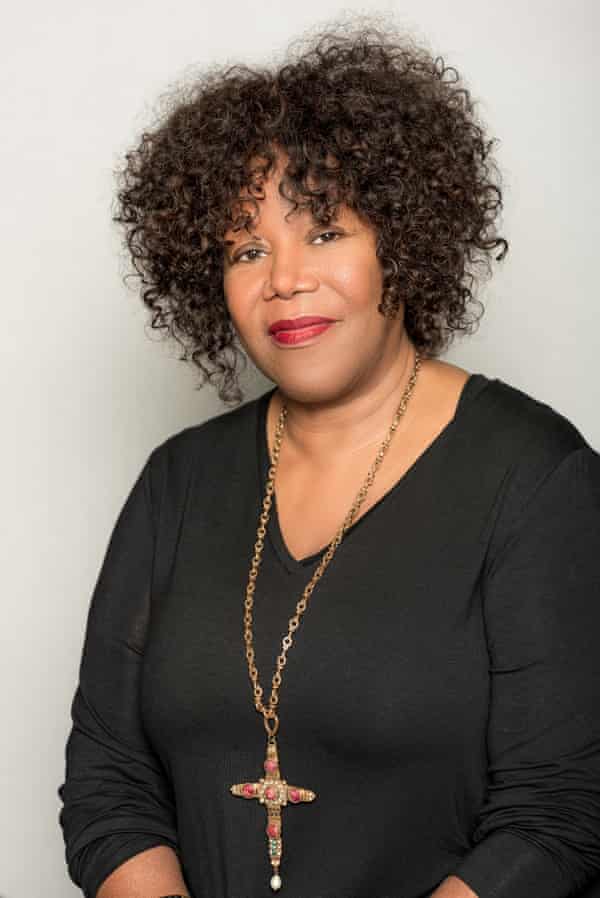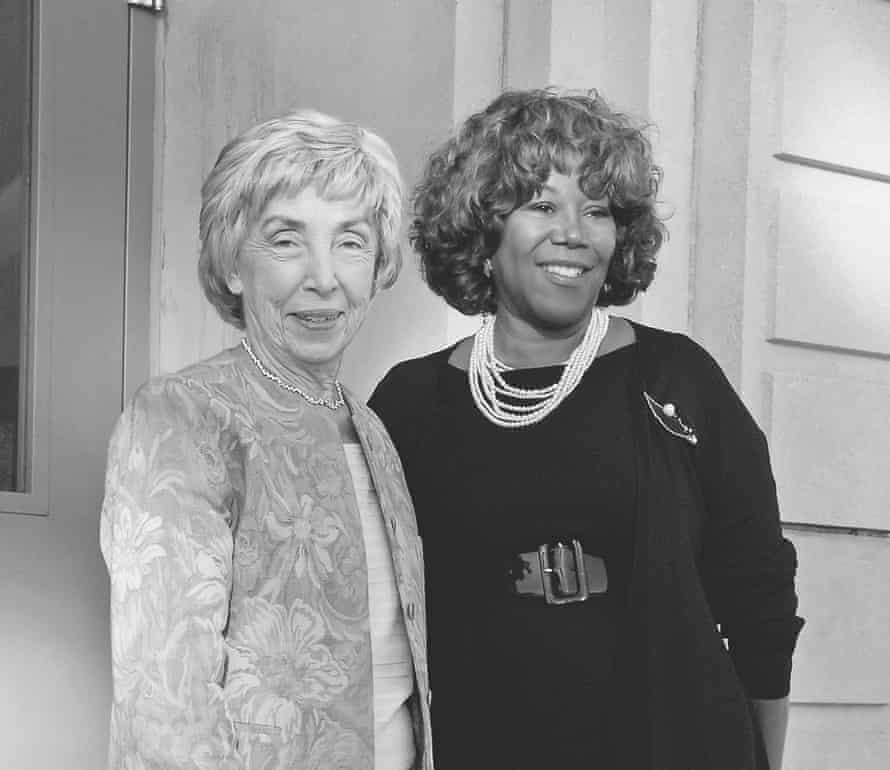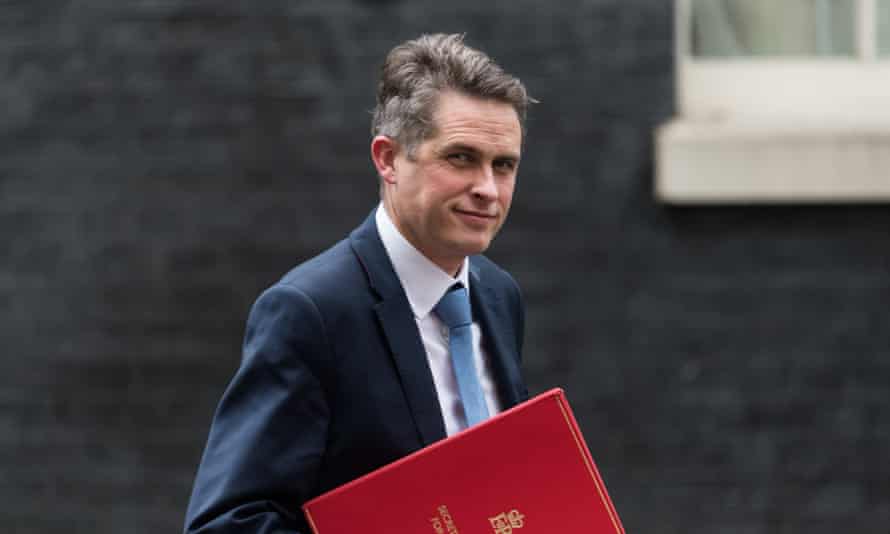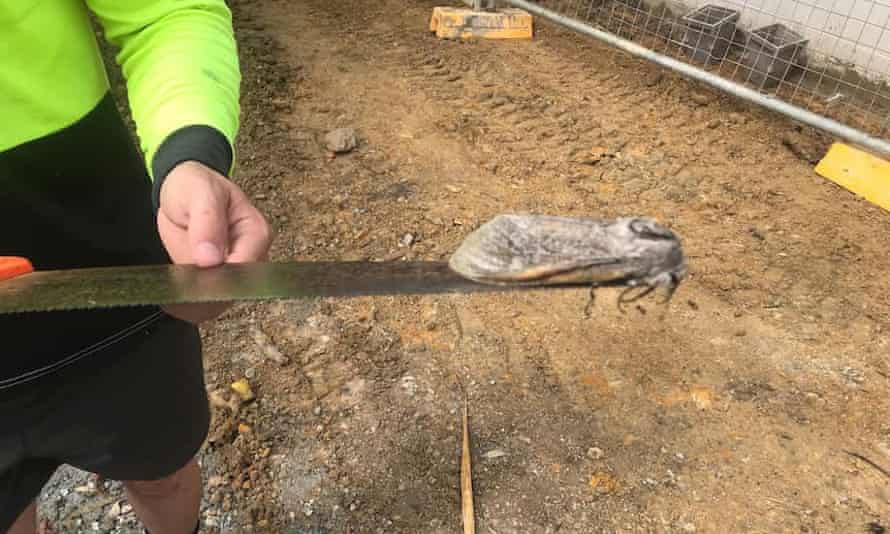
Ruby Bridges with an escort of US deputy marshals leaves school in November 1960. Photograph: anonymous/AP
Black lives
In 1960, she walked past hateful protesters to become the first Black child at a Louisiana school – and was then taught alone for a year. She discusses fear, forbearance and her fight for a better future
by Steve Rose
Thu 6 May 2021 10.00 BST
This year, Ruby Bridges saw some newly discovered video footage of her six-year-old self and was terrified for her. The footage was from 14 November 1960, a day that shaped the course of Bridges’ life and – it is no exaggeration to say – American history. Not that she was aware of it at the time. On that day she became the first Black child to attend an all-white primary school in Louisiana.
Looking at images of Bridges’ first day at William Frantz elementary school in New Orleans, she is a study in vulnerability: a tiny girl in her smart new uniform, with white socks and white ribbons in her hair, flanked by four huge federal agents in suits. Awaiting her at the school gates was a phalanx of rabidly hostile protesters, mostly white parents and children, plus photographers and reporters. They yelled names and racial slurs, chanted, and waved placards. One sign read: “All I want for Christmas is a clean white school.” One woman held up a miniature coffin with a black doll in it. It has become one of the defining images of the civil rights movement, popularised even further by Norman Rockwell’s recreation of it in his 1964 painting The Problem We All Live With.
The confrontation was expected. Three months before Bridges was born, the US supreme court had issued its landmark Brown v Board of Education ruling, outlawing segregation in schools nationwide. Six years later, though, states in the south were stubbornly refusing to act upon it. When nine African American children enrolled at the Little Rock school in Arkansas in 1957, it had caused an uproar. President Eisenhower had to call in federal troops to escort the children through a national guard blockade ordered by the governor. Three years later it was Louisiana’s turn. Bridges was one of six Black children to pass a test to gain access to formerly all-white schools. But two of the children dropped out and three went, on the same day, to a different school. So Bridges was all on her own.

Ruby Bridges: ‘I cannot even fathom me now, today, sending my child into an environment like that.’ Photograph: Thomas Dumont
Many have read resolve or defiance into Bridges’ demeanour that day, but the explanation is far simpler. “I was really not aware that I was going into a white school,” she says. “My parents never explained it to me. I stumbled into crowds of people, and living here in New Orleans, being accustomed to Mardi Gras, the huge celebration that takes place in the city every year, I really thought that’s what it was that day. There was no need for me to be afraid of that.”
Watching the footage of that day 60 years later, Bridges’ reaction was very different. “It was just mind-blowing, horrifying,” she says. “I had feelings that I’d never had before … And I thought to myself: ‘I cannot even fathom me now, today, as a parent and grandparent, sending my child into an environment like that.’”
Bridges, 66, can understand her own parents’ actions, though. They grew up as sharecroppers (poor tenant farmers) in rural Mississippi in the pre-civil rights era before moving to New Orleans in 1958. “They were not allowed to go to school every day,” she says. “Neither one of them had a formal education. If it was time for them to get the crops in, or to work, school was a luxury; that was something they couldn’t do. So they really wanted opportunities for their children that they were not allowed to have.”
Bridges’ parents paid a high price for their decision. Her mother, who had been the chief advocate for her attending the white school, lost her job as a domestic worker. Her father, a Korean war veteran who worked as a service-station attendant, also lost his job on account of the Bridges’ newfound notoriety. The National Association for the Advancement of Colored People (NAACP), which had played a big part in Bridges’ case, advised him not to go out and look for work, for his own safety. “That in itself caused a lot of tension,” she says, “because I’m the oldest of eight, and at that point he was no longer able to provide for his family. So they were solely dependent on donations and people that would help them.” The local corner store refused to serve them. Even her sharecropper grandparents were made to move from their farm in Mississippi. Her parents eventually separated. “I remember writing a letter to Santa Claus and asking him to give my father’s job back, and that he didn’t have a job because I was going to the school. So I guess somehow I did feel some blame for it.”
Many have read resolve or defiance into Bridges’ demeanour that day, but the explanation is far simpler. “I was really not aware that I was going into a white school,” she says. “My parents never explained it to me. I stumbled into crowds of people, and living here in New Orleans, being accustomed to Mardi Gras, the huge celebration that takes place in the city every year, I really thought that’s what it was that day. There was no need for me to be afraid of that.”
Watching the footage of that day 60 years later, Bridges’ reaction was very different. “It was just mind-blowing, horrifying,” she says. “I had feelings that I’d never had before … And I thought to myself: ‘I cannot even fathom me now, today, as a parent and grandparent, sending my child into an environment like that.’”
Bridges, 66, can understand her own parents’ actions, though. They grew up as sharecroppers (poor tenant farmers) in rural Mississippi in the pre-civil rights era before moving to New Orleans in 1958. “They were not allowed to go to school every day,” she says. “Neither one of them had a formal education. If it was time for them to get the crops in, or to work, school was a luxury; that was something they couldn’t do. So they really wanted opportunities for their children that they were not allowed to have.”
Bridges’ parents paid a high price for their decision. Her mother, who had been the chief advocate for her attending the white school, lost her job as a domestic worker. Her father, a Korean war veteran who worked as a service-station attendant, also lost his job on account of the Bridges’ newfound notoriety. The National Association for the Advancement of Colored People (NAACP), which had played a big part in Bridges’ case, advised him not to go out and look for work, for his own safety. “That in itself caused a lot of tension,” she says, “because I’m the oldest of eight, and at that point he was no longer able to provide for his family. So they were solely dependent on donations and people that would help them.” The local corner store refused to serve them. Even her sharecropper grandparents were made to move from their farm in Mississippi. Her parents eventually separated. “I remember writing a letter to Santa Claus and asking him to give my father’s job back, and that he didn’t have a job because I was going to the school. So I guess somehow I did feel some blame for it.”

Ruby’s mother, Lucille, next to the Norman Rockwell painting The Problem We All Live With. Photograph: Steve Ueckert/AP
Life at her new school was no easier for Bridges. For the first year, she needed federal protection every day since protesters were always at the school gates, including the woman with the doll in a coffin. “That I used to have nightmares about,” she says. “I would dream that the coffin was flying around my bedroom at night.” Bridges had to bring her own lunch every day for fear of being poisoned. The white parents all withdrew their children from the school, and the staff refused to teach Bridges, except for one teacher: Barbara Henry, who had come from Boston. For the first year, Henry taught Bridges alone, just the two of them in the classroom. “We knew we had to be there for each other,” says Bridges.
Bridges had another ally outside the school: Robert Coles, a white child psychiatrist who had witnessed the scenes outside the school, and volunteered to support her and her family, visiting the home on a weekly basis. Coles went on to establish a career studying the effects of desegregation on schoolchildren. It later emerged that it was one of his relatives who had sent Bridges her smart school clothes, which her family could never have afforded.
Things changed gradually. Over the course of that first year, a few white parents let their children back into the school. At first they were kept separate from Bridges. “The principal, who was part of the opposition, would take the kids and she would hide them, so that they would never come in contact with me.” Towards the end of the first year, however, on Henry’s insistence, Bridges was finally allowed to be part of a small class with other six-year-olds. “A little boy then said to me: ‘My mom said not to play with you because you’re a nigger,’” Bridges recalls. “And the minute he said that, it was like everything came together. All the little pieces that I’d been collecting in my mind all fit, and I then understood: the reason why there’s no kids here is because of me, and the colour of my skin. That’s why I can’t go to recess. And it’s not Mardi Gras. It all sort of came together: a very rude awakening. I often say today that really was my first introduction to racism.”
It was also an insight into the origins of racism, she later realised. “The way that I was brought up, if my parents had said: ‘Don’t play with him – he’s white, he’s Asian, he’s Hispanic, he’s Indian, he’s whatever – I would not have played with him.” The little boy wasn’t being knowingly racist towards her; he was simply explaining why he couldn’t play with her. “Which leads me to my point that racism is learned behaviour. We pass it on to our kids, and it continues from one generation to the next. That moment proved that to me.”
Life at her new school was no easier for Bridges. For the first year, she needed federal protection every day since protesters were always at the school gates, including the woman with the doll in a coffin. “That I used to have nightmares about,” she says. “I would dream that the coffin was flying around my bedroom at night.” Bridges had to bring her own lunch every day for fear of being poisoned. The white parents all withdrew their children from the school, and the staff refused to teach Bridges, except for one teacher: Barbara Henry, who had come from Boston. For the first year, Henry taught Bridges alone, just the two of them in the classroom. “We knew we had to be there for each other,” says Bridges.
Bridges had another ally outside the school: Robert Coles, a white child psychiatrist who had witnessed the scenes outside the school, and volunteered to support her and her family, visiting the home on a weekly basis. Coles went on to establish a career studying the effects of desegregation on schoolchildren. It later emerged that it was one of his relatives who had sent Bridges her smart school clothes, which her family could never have afforded.
Things changed gradually. Over the course of that first year, a few white parents let their children back into the school. At first they were kept separate from Bridges. “The principal, who was part of the opposition, would take the kids and she would hide them, so that they would never come in contact with me.” Towards the end of the first year, however, on Henry’s insistence, Bridges was finally allowed to be part of a small class with other six-year-olds. “A little boy then said to me: ‘My mom said not to play with you because you’re a nigger,’” Bridges recalls. “And the minute he said that, it was like everything came together. All the little pieces that I’d been collecting in my mind all fit, and I then understood: the reason why there’s no kids here is because of me, and the colour of my skin. That’s why I can’t go to recess. And it’s not Mardi Gras. It all sort of came together: a very rude awakening. I often say today that really was my first introduction to racism.”
It was also an insight into the origins of racism, she later realised. “The way that I was brought up, if my parents had said: ‘Don’t play with him – he’s white, he’s Asian, he’s Hispanic, he’s Indian, he’s whatever – I would not have played with him.” The little boy wasn’t being knowingly racist towards her; he was simply explaining why he couldn’t play with her. “Which leads me to my point that racism is learned behaviour. We pass it on to our kids, and it continues from one generation to the next. That moment proved that to me.”

Bridges with Barbara Henry at the unveiling of a statue in Ruby’s honour at William Frantz elementary school in 2014. Photograph: Courtesy of Ruby Bridges
By the time Bridges returned to the school for the second year, the furore had pretty much died down. There were no protests, she was in a normal-sized class with other children, predominantly white but with a few more African Americans. The overall situation had improved, although Bridges was upset that Henry had left the school (they have remained lifelong friends). Thanks to Henry’s teaching, Bridges spoke with a strong Boston accent, for which she was criticised by her teacher – one of those who had refused to teach her the year before. Every year, though, more and more Black students came to the school. By the time she moved on, high schools had been desegregated for nearly a decade, although Black and white pupils still did not mix. The south’s racist legacy was still close to the surface: her high school was named after a former Confederate general, Francis T Nicholls. Its sports teams were named the Rebels, and had a Confederate flag on their badge, which the Black students fought to change. (The school was renamed Frederick Douglass high school in the 1990s, and its teams are now the Bobcats.)
Bridges says she did not have much of a career plan when she finished school. “I was really more focused on how to get out of Louisiana. I knew that there was something more than what I was exposed to right there in my community.” She first applied for jobs as a flight attendant, then became a travel agent for American Express for 15 years, during which time she got to travel the world.
By her mid-30s, Bridges had satisfied her wanderlust and was married (to Malcolm Hall, in 1984) with four sons. But she felt restless. “I was asking myself: ‘What am I doing? Am I doing something really meaningful?’ I really wanted to know what my purpose was in life.” In 1993, Bridges’ brother was shot dead on a New Orleans street. For a time she cared for his four daughters, who also attended William Frantz elementary school. Then in 1995, Coles, now a Harvard professor, published his children’s book The Story of Ruby Bridges, which brought her back into the public eye. People in New Orleans had never really talked about her story, Bridges explains, in the same way that, for years, people in Dallas didn’t talk about the Kennedy assassination. “You have to understand, we didn’t have Black History Month during that time. It wasn’t like I could pick up a textbook and open it up and read about myself.” Bridges helped promote Coles’ book, talking in schools across the US. It became a bestseller. A few years later, Disney made a biopic of Bridges, on which she acted as a consultant. “I think everybody started to realise that me, Ruby Bridges, was actually the same little girl as in the Norman Rockwell painting.”
By the time Bridges returned to the school for the second year, the furore had pretty much died down. There were no protests, she was in a normal-sized class with other children, predominantly white but with a few more African Americans. The overall situation had improved, although Bridges was upset that Henry had left the school (they have remained lifelong friends). Thanks to Henry’s teaching, Bridges spoke with a strong Boston accent, for which she was criticised by her teacher – one of those who had refused to teach her the year before. Every year, though, more and more Black students came to the school. By the time she moved on, high schools had been desegregated for nearly a decade, although Black and white pupils still did not mix. The south’s racist legacy was still close to the surface: her high school was named after a former Confederate general, Francis T Nicholls. Its sports teams were named the Rebels, and had a Confederate flag on their badge, which the Black students fought to change. (The school was renamed Frederick Douglass high school in the 1990s, and its teams are now the Bobcats.)
Bridges says she did not have much of a career plan when she finished school. “I was really more focused on how to get out of Louisiana. I knew that there was something more than what I was exposed to right there in my community.” She first applied for jobs as a flight attendant, then became a travel agent for American Express for 15 years, during which time she got to travel the world.
By her mid-30s, Bridges had satisfied her wanderlust and was married (to Malcolm Hall, in 1984) with four sons. But she felt restless. “I was asking myself: ‘What am I doing? Am I doing something really meaningful?’ I really wanted to know what my purpose was in life.” In 1993, Bridges’ brother was shot dead on a New Orleans street. For a time she cared for his four daughters, who also attended William Frantz elementary school. Then in 1995, Coles, now a Harvard professor, published his children’s book The Story of Ruby Bridges, which brought her back into the public eye. People in New Orleans had never really talked about her story, Bridges explains, in the same way that, for years, people in Dallas didn’t talk about the Kennedy assassination. “You have to understand, we didn’t have Black History Month during that time. It wasn’t like I could pick up a textbook and open it up and read about myself.” Bridges helped promote Coles’ book, talking in schools across the US. It became a bestseller. A few years later, Disney made a biopic of Bridges, on which she acted as a consultant. “I think everybody started to realise that me, Ruby Bridges, was actually the same little girl as in the Norman Rockwell painting.”

Bridges in 2013 with Charles Burks, one of the marshals who escorted her to school. Photograph: Michael Conroy/AP
The proceeds from the book helped Bridges set up her foundation. Bringing her nieces back to William Frantz, she noticed the lack of after-school arts programmes, so set up her own. She continued touring schools across the country telling her story and promoting cultural understanding. (She recently had a new book published, This Is Your Time, retelling her story for today’s young people.) Then, in 2005, Hurricane Katrina struck New Orleans and the school was badly damaged. There were plans to tear it down. “I felt like if anybody was to save the school, it would be me,” she says. Bridges successfully campaigned to have the school put on the National Register of Historic Places, which freed funds to restore and expand it. “So now it has been reopened. Kids are back in the seats. And I’m really proud of the fact that I had something to do with that.” A statue of Bridges stands in the courtyard.
It was not until much later in life that Bridges became aware of Rockwell’s painting of her. It is not a faithful recreation of the scene (if anything it is closer to John Steinbeck’s eyewitness account in his 1962 book Travels With Charley in Search of America) but in contrast to Rockwell’s earlier cheery Americana, it captures the anger and drama: the N-word and “KKK” are scrawled across the wall behind Bridges, along with a splattered tomato.
The proceeds from the book helped Bridges set up her foundation. Bringing her nieces back to William Frantz, she noticed the lack of after-school arts programmes, so set up her own. She continued touring schools across the country telling her story and promoting cultural understanding. (She recently had a new book published, This Is Your Time, retelling her story for today’s young people.) Then, in 2005, Hurricane Katrina struck New Orleans and the school was badly damaged. There were plans to tear it down. “I felt like if anybody was to save the school, it would be me,” she says. Bridges successfully campaigned to have the school put on the National Register of Historic Places, which freed funds to restore and expand it. “So now it has been reopened. Kids are back in the seats. And I’m really proud of the fact that I had something to do with that.” A statue of Bridges stands in the courtyard.
It was not until much later in life that Bridges became aware of Rockwell’s painting of her. It is not a faithful recreation of the scene (if anything it is closer to John Steinbeck’s eyewitness account in his 1962 book Travels With Charley in Search of America) but in contrast to Rockwell’s earlier cheery Americana, it captures the anger and drama: the N-word and “KKK” are scrawled across the wall behind Bridges, along with a splattered tomato.

Bridges on a visit to schoolchildren in Canada.
Photograph: Rene Johnston/Toronto Star/Getty Images
When Barack Obama became president, Bridges suggested the painting be hung in the White House to commemorate the 40th anniversary of the event. Obama agreed, and invited Bridges and her family to its unveiling. He gave her a big hug. “It was a very powerful moment,” she says. “As we embraced, I saw people in the room tearing up and realised that it wasn’t just about he and I meeting; it was about those moments in time that came together. And all of those sacrifices in between he and I. He then turned to me and said: ‘You know, it’s fair to say that if it had not been for this moment, for you all, I might not be here today.’ That in itself is just a stark reminder of how all of us are standing on someone else’s shoulders. Someone else that opened the door and paved the way. And so we have to understand that we cannot give up the fight, whether we see the fruits of our labour or not. You have a responsibility to open the door to keep this moving forward.”
Ironically, and dishearteningly for Bridges, today William Frantz’s pupils are 100% Black. The white population had already begun moving out in the mid-60s, she explains, partly because of damage done by Hurricane Betsy, in 1965, but also in response to the changing demographics of the district. Today it is one of the poorest in the city, with relatively high crime rates. It is not just New Orleans: “white flight” has effectively resulted in a form of re-segregation in schools across the US.
Bridges sees this as the next battle: “Just as those people felt like it was unfair, and worked so hard during the civil rights movement to have those laws changed, we have to do that all over again. And we have to, first and foremost, see the importance of it. Because we’re faced with such division in our country, but where does that start? It starts very young. So I believe that it’s important, just like Dr King did, that our kids have an opportunity to learn about one another: to grow together, play together, learn together. The most time that kids spend away from home is in school, so our schools have to be integrated. And I know that there are arguments on both sides about that, but we’re never going to become the United States of America unless we, the people, are united.”
This Is Your Time by Ruby Bridges is published by One.
When Barack Obama became president, Bridges suggested the painting be hung in the White House to commemorate the 40th anniversary of the event. Obama agreed, and invited Bridges and her family to its unveiling. He gave her a big hug. “It was a very powerful moment,” she says. “As we embraced, I saw people in the room tearing up and realised that it wasn’t just about he and I meeting; it was about those moments in time that came together. And all of those sacrifices in between he and I. He then turned to me and said: ‘You know, it’s fair to say that if it had not been for this moment, for you all, I might not be here today.’ That in itself is just a stark reminder of how all of us are standing on someone else’s shoulders. Someone else that opened the door and paved the way. And so we have to understand that we cannot give up the fight, whether we see the fruits of our labour or not. You have a responsibility to open the door to keep this moving forward.”
Ironically, and dishearteningly for Bridges, today William Frantz’s pupils are 100% Black. The white population had already begun moving out in the mid-60s, she explains, partly because of damage done by Hurricane Betsy, in 1965, but also in response to the changing demographics of the district. Today it is one of the poorest in the city, with relatively high crime rates. It is not just New Orleans: “white flight” has effectively resulted in a form of re-segregation in schools across the US.
Bridges sees this as the next battle: “Just as those people felt like it was unfair, and worked so hard during the civil rights movement to have those laws changed, we have to do that all over again. And we have to, first and foremost, see the importance of it. Because we’re faced with such division in our country, but where does that start? It starts very young. So I believe that it’s important, just like Dr King did, that our kids have an opportunity to learn about one another: to grow together, play together, learn together. The most time that kids spend away from home is in school, so our schools have to be integrated. And I know that there are arguments on both sides about that, but we’re never going to become the United States of America unless we, the people, are united.”
This Is Your Time by Ruby Bridges is published by One.

































